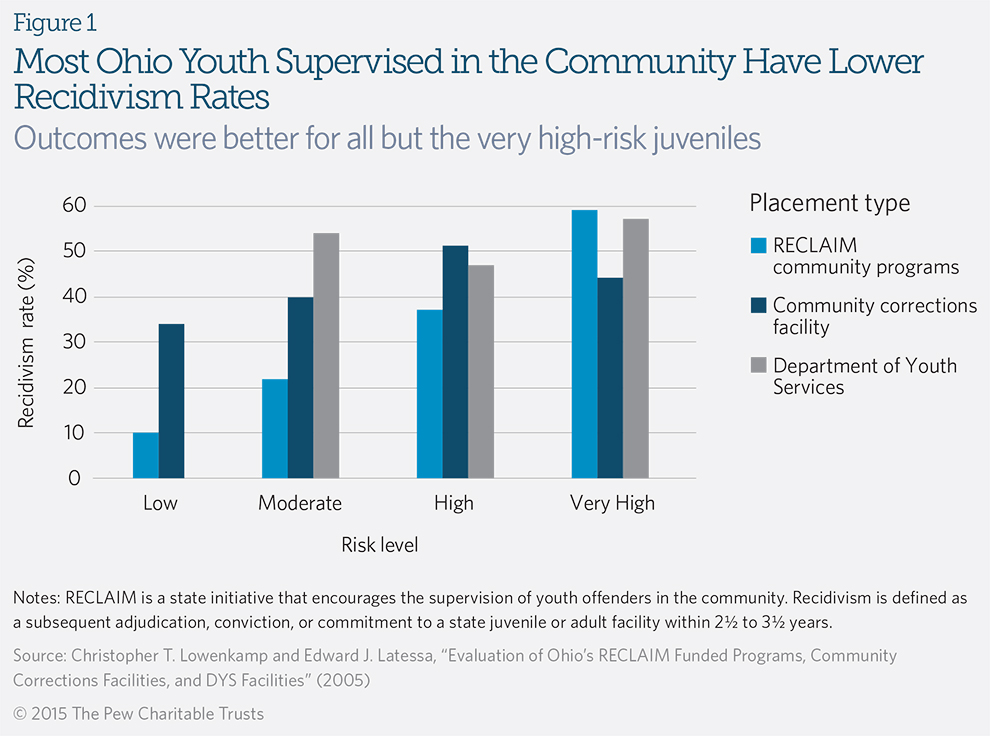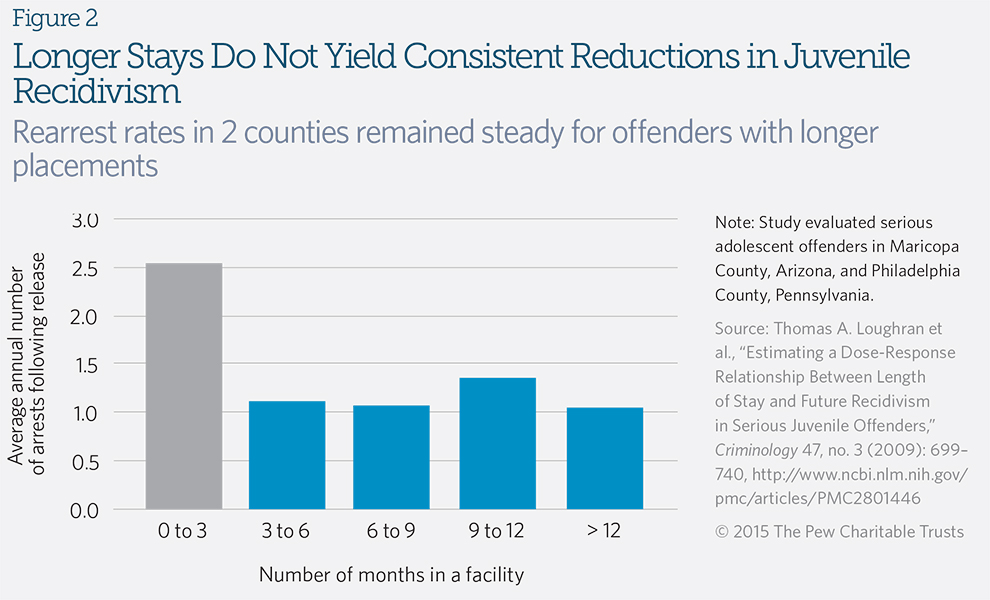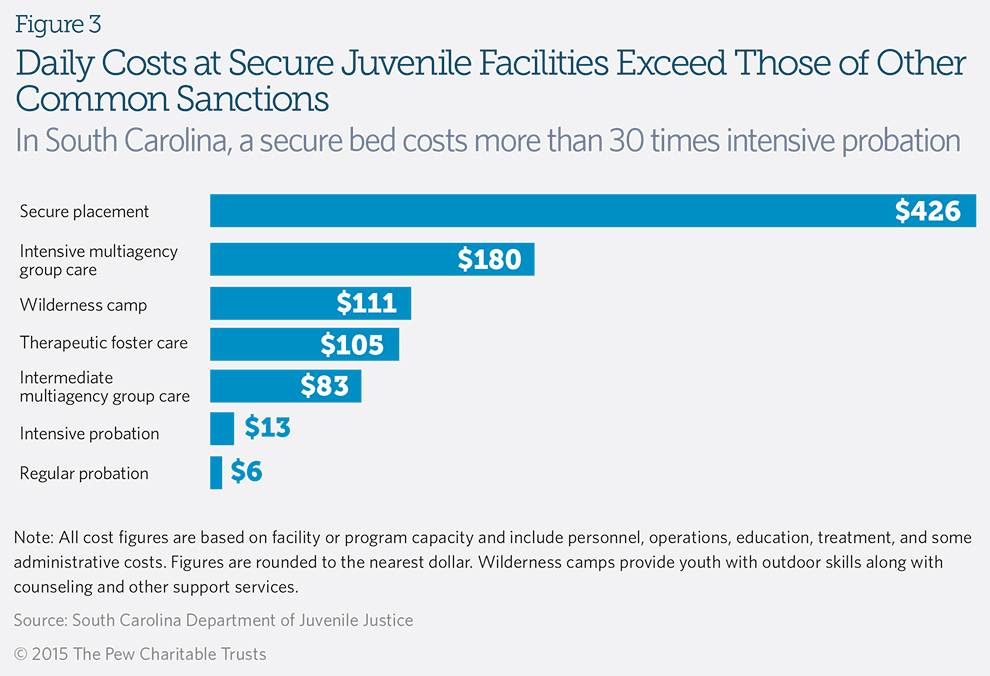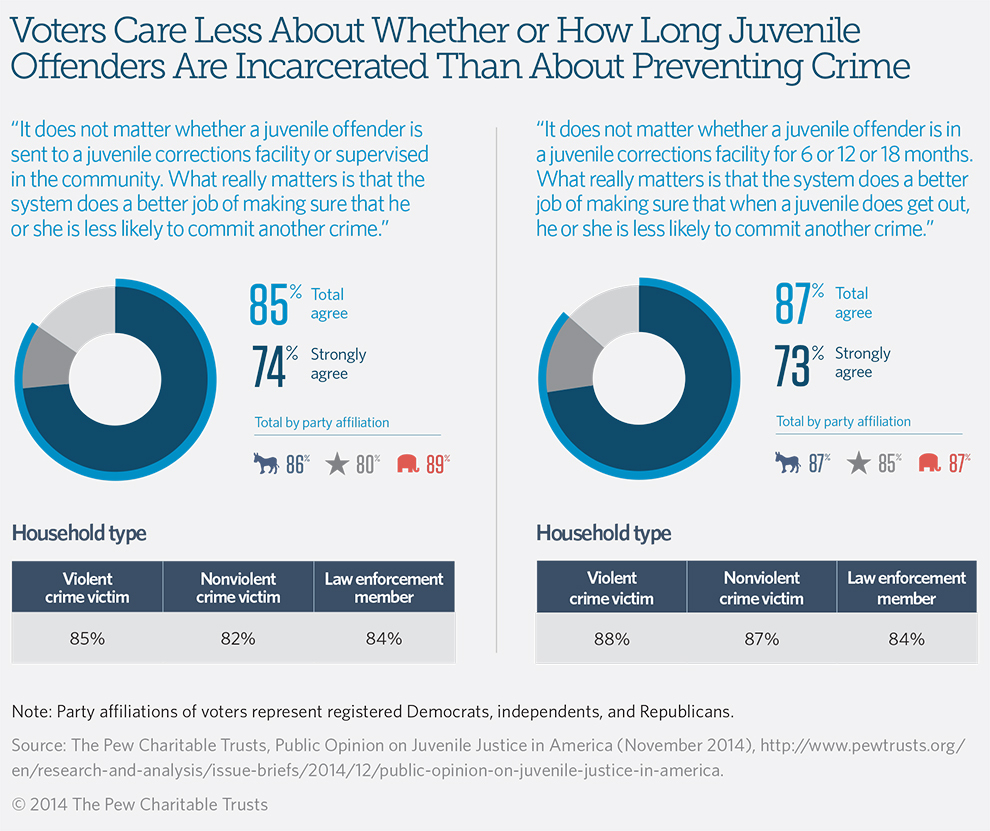Re-Examining Juvenile Incarceration
High cost, poor outcomes spark shift to alternatives
Overview
A growing body of research demonstrates that for many juvenile offenders, lengthy out-of-home placements in secure corrections or other residential facilities fail to produce better outcomes than alternative sanctions. In certain instances, they can be counterproductive. Seeking to reduce recidivism and achieve better returns on their juvenile justice spending, several states have recently enacted laws that limit which youth can be committed to these facilities and moderates the length of time they can spend there. These changes prioritize the use of costly facilities and intensive programming for serious offenders who present a higher risk of reoffending, while supporting effective community-based programs for others.
Out-of-home placements do not improve outcomes for most youth
In general, research has found that juvenile incarceration fails to reduce recidivism:
- Meta-analyses—studies that combine the results of multiple evaluations—suggest that placement in correctional facilities does not lower the likelihood of juvenile reoffending and may, in fact, increase it in some cases.1 One longitudinal study of serious adolescent offenders in Maricopa County, Arizona, and Philadelphia County, Pennsylvania, found that after matching youth offenders on 66 factors, including demographics and criminal history, those in placement fared no better in terms of recidivism than those on probation.2
- A separate analysis of the same data found that youth who reported the lowest levels of offending before being placed were more likely to reoffend following institutional stays.3
- In Texas, a recent study found that youth in community-based treatment, activity, and surveillance programs had lower rearrest rates than those with similar criminal histories and demographic characteristics who were released from state facilities.4
- An examination of long-term recidivism and education outcomes in Cook County, Illinois, found that juveniles who experienced confinement were more likely to drop out of high school and to be incarcerated as adults than youth offenders who were not incarcerated.5

Studies of juveniles at low risk to reoffend point to better recidivism outcomes for those who remain in community-based programs compared with those in out-of-home facilities:
- An evaluation of Ohio’s Reasoned and Equitable Community and Local Alternatives to the Incarceration of Minors (RECLAIM Ohio) program—a state initiative to supervise youth offenders in the community rather than placing them in institutions—found that the recidivism rate for low- and moderate-risk juveniles in facilities was at least twice that of comparable youth under supervision or in programs in their communities.6 (See Figure 1.) For all but the very high-risk group, recidivism outcomes were better for offenders supervised in the community than for those in facilities.7
- In a study of low-risk juvenile offenders, the Florida Department of Juvenile Justice reported that diversion programs demonstrated lower recidivism rates compared with more restrictive options and that out-of-home placement was associated with the highest recidivism rates.8
Evidence does not support longer lengths of stay
Several studies examining different populations and using various methodologies have found no consistent relationship between the length of out-of-home placements and recidivism. (See Figure 2.)
- One meta-analysis combining the results of juvenile and adult studies found that longer sentences were associated with a small increase in recidivism.9
- The Arizona and Pennsylvania longitudinal study referenced above reported that longer periods of confinement did not reduce recidivism in most cases.10 (See Figure 2.)
- A study in Florida found no consistent relationship between juveniles’ length of stay in confinement and the likelihood of recidivism.11
- An Ohio study found that, after controlling for juveniles’ demographics and risk levels, those placed in state facilities for longer periods had higher rates of re-incarceration than did those held for shorter periods.12
Research in the area of treatment duration is limited but suggests that the intensity and length of treatment should be consistent with the offender’s risk level to reduce the likelihood of future offending.13 Although some research has demonstrated a relationship between longer treatment periods or more contact hours and reduced recidivism, general agreement exists that extended treatment times show diminishing returns.14 Other factors, such as the risk levels of juveniles, the characteristics of programs, and the quality of their implementation, are key determinants in reducing recidivism, regardless of whether treatment is delivered in institutions or in the community.15

High cost to taxpayers, poor return on investment
High recidivism rates for juveniles released from out-of-home placements have prompted policymakers in several states to ask if the price tag is justified given the results. Though institutional placements vary substantially in cost, they are generally the most expensive options available for sanctioning young offenders. (See Figure 3.) States spend anywhere from tens to hundreds of thousands of dollars annually to hold a single juvenile offender in a corrections or other residential facility. The three-year outcomes in four states suggest a poor return on public investments:
- Nearly two-thirds of Georgia’s $300 million budget for the Department of Juvenile Justice was directed in 2013 to out-of-home facilities, including secure youth development campuses where housing an offender cost $91,126 annually. Sixty-five percent of juveniles released from these facilities in 2007 were re-adjudicated or convicted as adults within three years.16
- The cost of placing an offender at the Hawaii Youth Correctional Facility was $199,329 in 2013, and 3 in 4 youth released in 2005–07 were re-adjudicated or convicted within three years.17
- The average per-bed cost for Virginia’s six juvenile correctional centers (including the Reception and Diagnostic Center) was $85,549 in 2012, and 45 percent of offenders released in fiscal year 2008 were recommitted or incarcerated within three years.18
- In California, where the average annual cost of housing a juvenile offender in a state Department of Juvenile Justice facility was $179,400 in 2012,19 more than half (54 percent) of juvenile offenders released from these facilities in fiscal 2007 and 2008 were returned to custody in a state-level juvenile or criminal facility within three years.20

Voters prioritize rehabilitation and recidivism reduction
When it comes to the juvenile justice system, the major concerns of voters are rehabilitating offenders and reducing the likelihood that they will commit future crimes. A nationally representative poll of 1,200 registered voters in 2014 found that:
- Nearly 9 in 10 registered voters believe that juvenile correctional facilities should be used to house serious offenders and that policymakers should find less costly alternatives for lower-level offenders.
- 3 in 4 voters believe that juvenile offenders should receive treatment, counseling, and supervision to help them avoid reoffending, even if it means that they spend no time in a correctional facility.
- Voters support reducing the overall number of low-level juvenile offenders who are sent to correctional facilities and the length of time that these youth spend in such institutions.
- Voters strongly support using the cost savings from reduced juvenile confinement to build a more robust probation system.

States put research into action
In recent years, a number of states have passed laws excluding certain juveniles from being placed in state custody, reflecting a growing recognition of the steep cost and low public safety return of confining juveniles who commit lower-level offenses in residential facilities. Some states also have modified the length of time juveniles spend in custody. Because research shows little to no recidivism reduction from extended stays for many offenders, a handful of states have adopted mechanisms to evaluate youth placements and shorten them when appropriate.
Limiting out-of-home placements
- In 2014, Hawaii banned commitment to the state’s youth correctional facility for misdemeanor offenses.21
- Kentucky adopted reforms in 2014 that prohibit most misdemeanor offenders and Class D felons—the least serious class—from commitment to the Department of Juvenile Justice.22
- Georgia passed legislation in 2013 to prohibit residential commitment for all status offenses, such as skipping school or running away, and for misdemeanor offenders except those with four prior adjudications, including at least one felony.23
- In 2011, Florida banned state commitment for misdemeanors, with certain exceptions for youth with prior delinquency and those at high risk of reoffending.24
- In 2009, Mississippi prohibited commitment to the state training school for any juvenile offender adjudicated as delinquent for a nonviolent felony or with fewer than three misdemeanors.25
- In 2007, California banned state commitment for all low-level and nonviolent offenses.26
- As part of a complete overhaul of its juvenile corrections system in 2007, Texas barred commitments to secure facilities for misdemeanor offenses.27
- Several other states, including Ohio and Virginia, took steps to remove misdemeanor offenders from state commitment in the 1980s and 1990s.28
Moderating length of stay
- In 2014, Kentucky limited the amount of time a juvenile may be held by the Department of Juvenile Justice in out-of-home placement for treatment, and the total amount of time a youth may be committed or under court supervision.29
- In 2013, Georgia eliminated the mandatory minimum sentence for certain felony offenses and reduced the maximum term for less serious felony offenses from five years to 18 months.30
- In 2011, Ohio expanded judicial discretion in release decisions for committed youth.31 Legislation authorized the courts to release from the Department of Youth Services offenders serving mandatory sentences once certain minimum terms are met.32
Endnotes
- Daniel S. Nagin, Francis T. Cullen, and Cheryl Lero Jonson, “Imprisonment and Reoffending,” Crime and Justice: A Review of Research 38 (2009): 115–200; Paula Smith, Claire Goggin, and Paul Gendreau, The Effects of Prison Sentences and Intermediate Sanctions on Recidivism: General Effects and Individual Differences (January 2002), http://www.publicsafety.gc.ca/cnt/rsrcs/pblctns/ffcts-prsn-sntncs/index-eng.aspx; and Patrice Villettaz, Martin Killias, and Isabel Zoder, “The Effects of Custodial vs. Noncustodial Sentences on Re- Offending: A Systematic Review of the State of Knowledge” Campbell Systematic Reviews 13 (October 2006): doi:10.4073/csr.2006.13. These reviews synthesize the results of individual adult and juvenile justice studies that compared the effects on recidivism of custodial sanctions with those of alternatives. In each review, including for juvenile samples, the weight of the evidence suggests that incarceration does not reduce recidivism.
- Thomas A. Loughran et al., “Estimating a Dose-Response Relationship Between Length of Stay and Future Recidivism in Serious Juvenile Offenders,” Criminology 47, no. 3 (2009), 699–740, http://www.ncbi.nlm.nih.gov/pmc/articles/PMC2801446/. This study standardized recidivism as an average yearly rate of rearrest, controlling for time in the community over the 48-month follow-up period.
- Edward P. Mulvey et al., “Trajectories of Desistance and Continuity in Antisocial Behavior Following Court Adjudication Among Serious Adolescent Offenders,” Development and Psychopathology 22 (November 2010): 453–75, doi: 10.1017/S0954579410000179. This study included multiple measures of self-reported offending collected every six months during a three-year period following adjudication and a baseline interview.
- Tony Fabelo et al., “Closer to Home: An Analysis of the State and Local Impact of the Texas Juvenile Justice Reforms” (January 2015), http://csgjusticecenter.org/wp-content/uploads/2015/01/texas-JJ-reform-closer-to-home.pdf.
- Anna Aizer and Joseph J. Doyle Jr., “Juvenile Incarceration, Human Capital and Future Crime: Evidence From Randomly-Assigned Judges,” working paper, National Bureau of Economic Research (June 2013), http://www.mit.edu/~jjdoyle/aizer_doyle_judges_06242013.pdf.
- Christopher T. Lowenkamp and Edward J. Latessa, Evaluation of Ohio’s RECLAIM Funded Programs, Community Corrections Facilities, and DYS Facilities (2005), http://www.uc.edu/content/dam/uc/ccjr/docs/reports/project_reports/ Final_DYS_RECLAIM_Report_2005.pdf.
- Ibid. This study included multiple measures of recidivism. In this instance, recidivism refers to a subsequent adjudication, conviction, or commitment to a state juvenile or adult facility within the 2½- to 3½-year follow-up period.
- Michael Baglivio, Florida Department of Juvenile Justice, “Briefing Report: The Risk Principle” (2013), http://www.djj.state.fl.us/docs/ research2/briefing-report-the-risk-principle.pdf?sfvrsn=0. This study measured recidivism as a subsequent adjudication or conviction within 12 months of program completion.
- Smith, Goggin, and Gendreau, The Effects of Prison Sentences.
- Loughran et al., “Estimating a Dose-Response Relationship.”
- Kristin P. Winokur et al., “Juvenile Recidivism and Length of Stay,” Journal of Criminal Justice 36 (2008): 126–37. This study measured recidivism as a subsequent adjudication or conviction for an offense within 12 months of release to the community or to a conditional-release program.
- Brian K. Lovins, “Putting Wayward Kids Behind Bars: The Impact of Length of Stay in a Custodial Setting on Recidivism” (PhD diss., University of Cincinnati, 2013), http://cech.uc.edu/content/dam/cech/programs/criminaljustice/docs/phd_dissertations/ lovinsb.pdf. This study measured recidivism as a subsequent commitment to a juvenile or adult correctional facility for a new offense within a three-year follow-up period.
- James C. Howell and Mark W. Lipsey, “Research-Based Guidelines for Juvenile Justice Programs,” Justice Research and Policy 14, no. 1 (November 2012): 17–34; Jeff Latimer et al., Department of Justice Canada, Treating Youth in Conflict With the Law: A New Meta- Analysis (April 2003), http://www.justice.gc.ca/eng/rp-pr/cj-jp/yj-jj/rr03_yj3-rr03_jj3/rr03_yj3.pdf; Mark W. Lipsey, “Primary Factors That Characterize Effective Interventions With Juvenile Offenders: A Meta-Analytic Overview,” Victims & Offenders 4, no. 2 (April 2009): 124–47, doi:10.1080/15564880802612573; and Mark W. Lipsey, David B. Wilson, and Lynn Cothern, “Effective Intervention for Serious Juvenile Offenders,” Juvenile Justice Bulletin (April 2000).
- Ibid.
- Howell and Lipsey, “Research-Based Guidelines”; and Lipsey, “Primary Factors.”
- The Pew Charitable Trusts, Georgia’s 2013 Juvenile Justice Reform: New Policies to Reduce Secure Confinement, Costs, and Recidivism (July 2013), http://www.pewtrusts.org/en/research-and-analysis/reports/0001/01/01/georgias-2013-juvenile-justice-reform.
- The Pew Charitable Trusts, Hawaii’s 2014 Juvenile Justice Reform: New Law Will Strengthen Community Supervision and Reduce Secure Confinement (July 2014), http://www.pewtrusts.org/Research-and-Analysis/Issue-Briefs/2014/07/Hawaiis-2014-Juvenile-Justice-Reform.
- Virginia Department of Juvenile Justice, Data Resource Guide, Fiscal Year 2012 (February 2013), http://www.djj.virginia.gov/pdf/AboutDJJ/DRG/FY2012_DRG.pdf.
- California Legislative Analyst’s Office, Completing Juvenile Justice Realignment (February 2012), http://www.lao.ca.gov/analysis/2012/crim_justice/juvenile-justice-021512.pdf.
- California Department of Corrections and Rehabilitation, 2012 Outcome Evaluation Report (October 2012), http://www.cdcr.ca.gov/adult_research_branch/Research_Documents/ ARB_FY_0708_Recidivism_Report_10.23.12.pdf.
- The Pew Charitable Trusts, Hawaii’s 2014 Juvenile Justice Reform.
- The Pew Charitable Trusts, Kentucky’s 2014 Juvenile Justice Reform: New Law Will Strengthen Community Supervision and Reduce Secure Confinement (July 2014), http://www.pewtrusts.org/en/research-and-analysis/issue-briefs/2014/07/kentuckys-2014-juvenile-justice-reform. Exceptions include youth who have been adjudicated for deadly weapon offenses or offenses that would classify them as sex offenders, or those who have three or more prior delinquency adjudications or four or more previous adjudications for supervision violations.
- The Pew Charitable Trusts, Georgia’s 2013 Juvenile Justice Reform.
- Florida Senate Bill 2114 (2011), http://www.flsenate.gov/Session/Bill/2011/2114.
- Mississippi Senate Bill 2984 (2009), http://billstatus.ls.state.ms.us/documents/2010/html/SB/2900-2999/SB2984SG.htm.
- California Senate Bill 81 (2007), http://www.leginfo.ca.gov/pub/07-08/bill/sen/sb_0051-0100/sb_81_bill_20070824_chaptered.pdf. Counties may send an offender to a state facility only if he or she has committed one of the serious or violent offenses listed in section 707(b) of the California Welfare and Institutions Code, or a sex offense listed in Penal Code 290 (d)(3).
- Texas Senate Bill 103 (2007), http://www.legis.state.tx.us/billlookup/text.aspx?LegSess=80R&Bill=SB103.
- Ohio Code § 2152.16, http://codes.ohio.gov/orc/2152.16 and Virginia Code § 16.1-278.8(A)(14), https://leg1.state.va.us/cgi-bin/legp504.exe?000+cod+16.1-278.8.
- The Pew Charitable Trusts, Kentucky’s 2014 Juvenile Justice Reform.
- The Pew Charitable Trusts, Georgia’s 2013 Juvenile Justice Reform.
- Ohio House Bill 86 (2011), http://archives.legislature.state.oh.us/BillText129/129_HB_86_EN_N.html. Also see Ohio Criminal Sentencing Commission, “HB 86 Summary” (August 2011), 34, http://opd.ohio.gov/Legislation/Le_OhioCrimSentSummary.pdf.
- Ibid.






